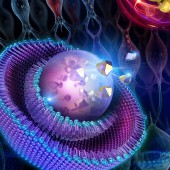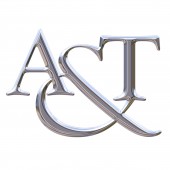Ocular Nanotechnology Magazine Cover Illustration by Cynthia Turner |
Home > Winners > #154797 |
 |
|
||||
| DESIGN DETAILS | |||||
| DESIGN NAME: Ocular Nanotechnology PRIMARY FUNCTION: Magazine Cover Illustration INSPIRATION: An illustration for the cover of EyeNet, the magazine of the American Academy of Ophthalmology, for their annual meeting and special annual issue. I created the nanocarriers individually in Cinema4D, a 3D software program, and then composed them in Photoshop on a background of a field of the rods and cones cells found at the back of the eye. I enhanced the rendered 3D models by reflecting the colors from one into the other, and creating light effects to add movement and excitement to the composition. UNIQUE PROPERTIES / PROJECT DESCRIPTION: Nanoparticles are 1 to 100 nanometres in diameter and have unique properties due to their small size and high surface area to volume ratio. Nanoparticles are the most common nanocarriers for ocular therapeutics due to their biocompatibility and their capacity to be loaded with drugs and gene therapies by chemical attachment, embedment, or encapsulation in the nanocarrier. Highlighting four types of nanotechnology-based ocular drug delivery systems delivering their payloads to the back of the eye, clockwise starting at noon: nanopolymer, nanoemulsion, nanomicelle, and liposome. OPERATION / FLOW / INTERACTION: The Art Director requested an illustration with a science fiction futuristic feel to be used for their special annual issue, which is also released on the occasion of the American Academy of Ophthalmology's annual meeting and is used to brand the meeting. PROJECT DURATION AND LOCATION: The project was in development for two weeks at the artist's studio in Santa Rosa Beach, Florida, USA. FITS BEST INTO CATEGORY: Computer Graphics, 3D Modeling, Texturing, and Rendering Design |
PRODUCTION / REALIZATION TECHNOLOGY: Created using Cinema 4D, a 3D modeling program, 3D Models, and hand-painting in Photoshop, using a stylus and tablet on a Mac. SPECIFICATIONS / TECHNICAL PROPERTIES: Width 431.8 mm width x Height 279.4 mm, 300 dpi, tiff TAGS: medical illustration, biomedical artist, visual science, ophthamology, nanocarriers, ocular drug delivery RESEARCH ABSTRACT: The artist researched the morphology of the 4 specified nanocarriers and created accurate scientific visualizations of them. Each nanocarrier was separately modeled and imaged in a 3D program, and then brought into a Photoshop document. The composited tiff was finished by handpainting in Photoshop to reflect light from one element to the next to bring color harmony to the palette. Additional motion elements were painted to tie the composition together and lead the eye in reading the image. CHALLENGE: Create accurate depictions of ocular drug delivery nanocarriers and arrange the four carriers in a pleasing composition that did not necessarily give one precedence in importance over another. ADDED DATE: 2023-09-28 03:18:06 TEAM MEMBERS (1) : IMAGE CREDITS: Image #1: Illustrator Cynthia Turner / Alexander and Turner Medical Illustration Studio / Ocular Nanotechnology, 2023 Image #2: Illustrator Cynthia Turner / Alexander and Turner Medical Illustration Studio / Ocular Nanotechnology, 2023 Image #3: Illustrator Cynthia Turner / Alexander and Turner Medical Illustration Studio / Ocular Nanotechnology, 2023 Image #4: Illustrator Cynthia Turner / Alexander and Turner Medical Illustration Studio / Ocular Nanotechnology, 2023 Image #5: Illustrator Cynthia Turner / Alexander and Turner Medical Illustration Studio / Ocular Nanotechnology, 2023 PATENTS/COPYRIGHTS: Copyrights belong to Cynthia Turner, 2023 |
||||
| Visit the following page to learn more: https://bit.ly/2LaPaFG | |||||
| AWARD DETAILS | |
 |
Ocular Nanotechnology Magazine Cover Illustration by Cynthia Turner is Winner in Computer Graphics, 3D Modeling, Texturing, and Rendering Design Category, 2023 - 2024.· Press Members: Login or Register to request an exclusive interview with Cynthia Turner. · Click here to register inorder to view the profile and other works by Cynthia Turner. |
| SOCIAL |
| + Add to Likes / Favorites | Send to My Email | Comment | Testimonials | View Press-Release | Press Kit |







